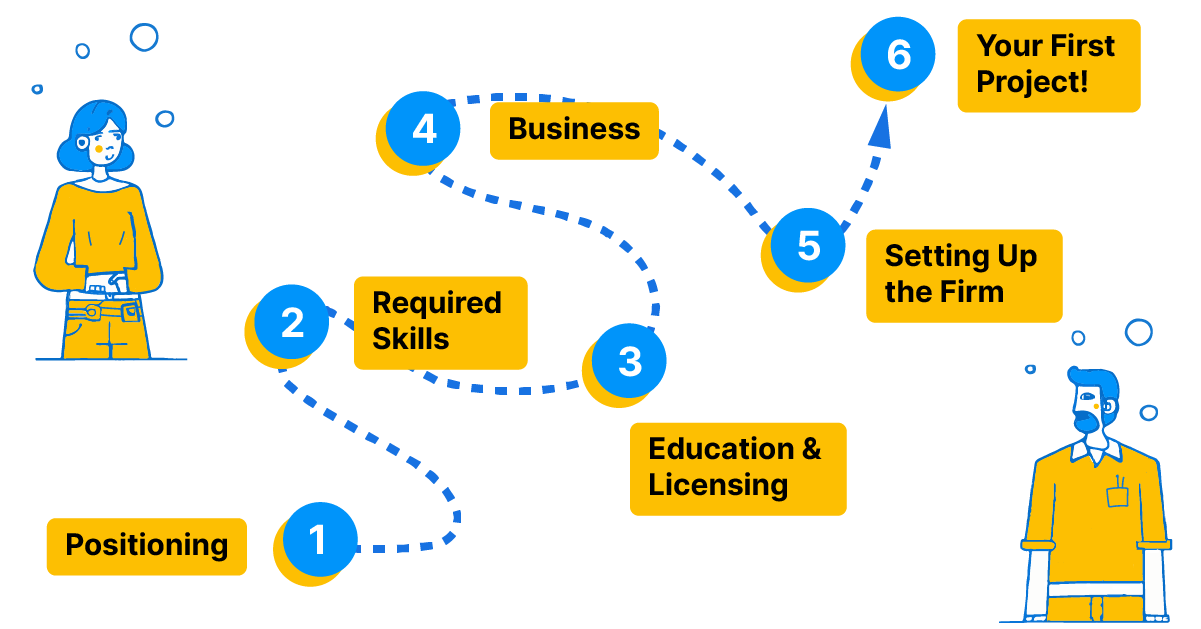In your life as an architect there comes a day when you ask yourself the question: Should I start my own firm? How do I start my own architecture firm?
Whether you’re intrigued by the prospects of managing your own projects, setting your own timelines, or making your mark in the architectural world with a strong team of creatives, setting up your own firm is every architect’s dream.
And rightly so, starting your own architecture firm can be one of the most fulfilling steps you’ll undertake in your professional career!
But like any significant endeavor, it requires careful planning, a trove of knowledge, commitment, and an array of vital skills.
In this post, we’ll embark on this adventure together. We’ll cover everything you need to know from understanding and positioning yourself in the architectural industry, acquiring necessary skills and licensing, to business planning and setting up your firm. By the time we’re done, you’ll have a comprehensive roadmap on how to start an architecture firm. Let’s get started!
Step 1: Carving Your Niche: Positioning Yourself in the Architecture Industry
The first thing you should ask yourself, is: What type of architecture firm do you want to create? Are you drawn to high-end architecture with prestigious, landmark projects, or does the idea of a smaller, local firm working on residential or community-based buildings appeal more to you? Are you looking to create innovative, experimental designs, or do you prefer grounded, tried-and-tested architectural styles?
Your answers will define the kind of market you’ll serve and consequently, where your projects will be. Going small-scale and hyper-local? This approach allows for personal oversight on every project, giving you the opportunity to follow through with a project from inception to the final product. If, on the other hand, you want to seek opportunities to design buildings nation-wide or even internationally, you’ll likely find yourself collaborating with Local Design Institutes (LDIs) to bring your designs to fruition.
Why is this important?

Finding Your Place (literally)
Knowing the kind of architecture office you want to create might necessitate careful selection of your firm’s location. An urban setting may provide more opportunities for collaboration with other architects and engineers and lead to more high-end projects, while a smaller city or town might offer the chance to have a real impact on the local architectural landscape.
But there is no one-size-fits all. There are plenty of world-class design firms that operate from remote places. Peter Zumthor, renown Swiss architect, established his office in a remote building in the Swiss alps, yet he designs buildings as far away as L.A..
Still, by and large, architecture firms design and build the majority of their designs within a certain distance from where they are based. Herzog & de Meuron for instance, known for their international projects, design around 75% of their projects within Switzerland, where their main offices are!
Thus, positioning your firm in the industry is like establishing a solid foundation. It’s an important step that ensures your firm stands tall, regardless of market shifts.
Step 2: Essential Skills for Starting an Architecture Firm
Once you start an architecture firm, you’re no longer just an architect; you’re a business owner, a team leader, a project manager, and a marketer. To set yourself up for success, make sure you bring the required skills and knowledge.
Firstly, as you might expect, design skills are paramount. Architecture is, after all, a fine balance of form and function. Your ability to conceptualize spaces that are aesthetically pleasing, functional, and meet clients’ needs is at the heart of what you do. Still, what’s state-of-the-art changes fast, be it BIM or computational design. But your skills must extend beyond the drafting table.
Project management expertise is another critical skill to possess. From budgeting to scheduling, quality control to compliance with regulations, this aspect of running an architecture firm is both crucial and complex. It demands a solid understanding of the entire project life cycle and the ability to anticipate and mitigate any potential pitfalls.
But let’s not forget leadership – an often under-appreciated but vital attribute. As the head of your firm, you’ll be directing teams, liaising with clients, and collaborating with various professionals. Your ability to inspire, motivate, and lead your team will significantly influence the success of your projects and the growth of your firm. You’ll also be managing finances, developing marketing strategies, and fostering client relationships. Understanding the basics of business, from financial management to strategic planning, is non-negotiable.
On the technical side, you must be well-versed with the laws and regulations of your operating region. This understanding ensures you deliver compliant, safe, and sustainable designs that reflect your clients’ vision. Delivering high-quality buildings is essential to build your reputation and get follow-up jobs!

Do Your Best, But Know Your Limits
Lastly, don’t underestimate the power of soft skills, such as communication, negotiation, and networking. These abilities enable you to build strong relationships with clients, suppliers, and other stakeholders, which is integral to the success of your architecture firm. At some point you are going to run into a client that will make your life difficult, and having the fortitude and equanimity to deal with that is going to save you a lot of headaches.
If you’re reading this and thinking, “I don’t have all these skills!”, don’t panic. You can always improve your architecture skills. But you also don’t need to have all those skills yourself! Most new architecture firms begin as a collaboration between architects. Your team can divide responsibilities based on each person’s strengths, enabling each of you to learn and grow together. It can build confidence and be a lot of fun too!
And even if you start out on your own, the first few years are going to be a learning process. You are going to meet and overcome(!) new challenges every day. And with that you will build your resilience, experience and reputation!
So, once you feel confident about your skills and knowledge, you can move on to the next phase: understanding educational requirements and licensing.
Step 3: Educational Requirements and Licensing
Starting an architecture firm requires more than an understanding of your market and a strong skill set. You also need to meet specific educational and licensing requirements.
Educational requirements
Architecture is too complex of a field to jump into without a thorough education. At a minimum, you’ll need a Bachelor’s degree in Architecture. However, most architecture firm owners often hold a Master’s degree in Architecture or a related field. These programs provide a robust theoretical foundation and an understanding of practical aspects, equipping you to navigate the intricacies of architectural design and execution. The great thing about architectural education is its universality; while practices may vary, the fundamental principles are applicable globally.
I want to add that in my experience, the most important thing you’ll learn in architecture school is how to design. You can learn everything else during your first years as a junior architect, but there won’t be the time or the opportunity to learn how to design great architecture once you are in the industry. Learning how to put together a building, the laws and regulations, everything practical is usually learned on the job. The same goes for architectural software. Which is why architectural internships are an important part of the architecture education journey.

Licensing Requirements
However, licensing is a different story. It’s the critical key that unlocks the door to starting and running an architecture firm. The licensing requirements, though, are more localized and vary significantly from country to country. In the United States, for instance, obtaining a license involves meeting the stipulations laid out by the National Council of Architectural Registration Boards (NCARB). This typically involves fulfilling an Intern Development Program, passing the Architect Registration Examination, and in many cases, having a degree from a school accredited by the National Architectural Accrediting Board (NAAB).
The American Institute of Architects (AIA) – also offers a guide on starting an architecture firm. It delves deeper into practical advice and industry norms for setting up an architecture firm in the U.S..
Securing your license is much like a rite of passage in the journey of starting an architecture firm. It attests to your ability to practice architecture professionally and responsibly, safeguarding the public’s interest and safety. It’s more than just a legal requirement; it’s an embodiment of your professional commitment to the field of architecture.
Remember, starting an architecture firm isn’t a sprint; it’s more like a marathon. Think about it, so many famous architects today are in their 80s! It’s a long process that involves education, skill development, and licensing. But, with patience, persistence, and most importantly a passion for architecture, you’re well on your way to building an architecture firm that stands out in the industry.
With these foundational pillars in place, let’s now explore the business and financial planning aspect of starting an architecture firm. Because, after all, great architecture is not just about inspired design, it’s also about the viability and sustainability of the firm that produces it.
Step 4: Business and Financial Planning for Your Architecture Firm
This is a tricky one. Here is the truth: Architecture is considered a high-risk business. There won’t always (or ever?) be a steady stream of projects, sometimes there will be too much work and sometimes too little. Many architects start their firms without any experience in business, yet they are facing one of the most challenging business to run out there! But there are things you can do to ensure that your firm will thrive.
You’ll need a business plan – your firm’s blueprint – to guide your journey. In this section, we’ll draft the critical elements you’ll need to consider in your business and financial planning phase when learning how to start an architecture firm.

Just as every building begins with a blueprint, every business starts with a plan. Your business plan outlines your firm’s objectives, strategies, market analysis, financial forecasts, and operational structures. Far from a definitive guide, I’ll try to offer you direction and focus as you navigate the trials and triumphs of building your firm.
One of the most significant aspects of your business plan is financial planning. There will be fluctuations in your firm’s income throughout the year. You’ll need to plan as far ahead as you can with the limited amount of information you have. What is the outlook for projects in the coming three months, the coming year? How is the staffing? Project often stop unexpectedly, and sometimes you’ll win many jobs at once. As such, ensuring that you have adequate financial and staffing resources to weather these ebbs and flows is vital.
Balancing Architecture and Business
It’s essential to stay flexible and stay positive, but also to be realistic. You’ll need to consider your startup costs, including hardware, software, office space, and salaries, and project your revenue realistically. Be prepared that the first few years might be challenging as you establish your business. Make sure you have a buffer of at least 6 months to cover whatever expenses you have.
That being said, staying true to your vision is key as you dive into the work. As projects start rolling in, it’s easy to lose sight of the reasons you started your architecture firm. Use your business plan as your roadmap. Don’t be afraid to turn down projects if they don’t align with your objectives. Remember, the goal is to build a thriving business that reflects your architectural vision, not to simply survive.
Sometimes architects start a firm with the vision of doing things differently than where they worked before and they end up drowning in the same work they tried to stay clear from. Remember, you are in control!
Finally, patience is your greatest ally. Rome wasn’t built in a day, and neither will your architecture firm be. The process of establishing a firm, earning a reputation, and cultivating a client base takes time.
Having solidified the business and financial structures, we’ll move on to the practical aspects of setting up your firm. Much like transitioning from blueprints to the construction phase, we’re about to put our plans into action. Let’s delve into the next stage: setting up the firm.
Step 5: From Concept to Reality: Steps to Setting Up the Firm
We’ve designed the blueprint and laid the foundation. Now, it’s time to start constructing your architecture firm. In this section, we’ll navigate the practical steps of setting up the firm, from registering your business to investing in necessary software and hardware.
Firstly, ensure that your architecture firm is legally established. This process involves registering as a business entity – a critical step in providing legal protection and establishing the firm’s credibility. Keep in mind that regulations and processes can vary widely from country to country, so it’s crucial to familiarize yourself with the specific requirements in your location. Additionally, registration with the local chamber of architects may be required in some jurisdictions.

Work From Home or Downtown Office?
Next, let’s talk about your office. Especially at the beginning, when you are eager to get started your might be tempted to rent the office space you envision for your firm. But by doing so you risk to overextend financially. Having an office doesn’t define an architecture firm; the ability to secure and deliver on architectural projects does. So, consider starting small and scale up as your business grows. Your firm’s location can range from a home office to renting a shared workspace, depending on your budget and project pipeline.
Now, it’s time to equip your firm with the tools of the trade. In today’s digital age, software forms the backbone of any architecture firm. From drafting and 3D modeling tools like Rhino and Grasshopper, the Adobe Suite and Revit to project management platforms, investing in the necessary software is non-negotiable. The subscription models for software is quite flexible these days, so consider only adding licenses when a project requires. Similarly, reliable hardware – computers, printers, and drafting equipment – forms an integral part of your setup.
With the firm set up and ready to go, it’s time to get the ball rolling and secure your first job. In the next section, we’ll explore how to pave your way into the industry, create a strong portfolio, and make a name for your firm in the competitive world of architecture.
Step 6: Winning Your First Job as an Architecture Firm
With the firm established, it’s time to dive into the real world of architecture and secure your first project. Landing that initial gig isn’t just about financial gain—it’s a step towards building a portfolio, showcasing your capabilities, and carving out your niche in the architecture industry. And it’s an exciting, confidence-boosting sign that what you’ve been dreaming of for so long is coming true: you have your own architecture firm! Here are some strategies on how to get your first architecture project when you start your firm.
Start by announcing your new venture to everyone you know. In the architecture world, connections and relationships can lead to unexpected opportunities. Your network—comprising past clients, colleagues, friends, and family—could help you discover potential leads. Your first job might be closer than you think!
Design competitions represent another viable route to your first project. They provide a platform to demonstrate your design prowess and originality, even if you don’t secure the top spot. Winning a competition could catapult your firm into the limelight, but remember that the primary goal is to gain visibility and experience.
One strategy could be to do design competitions on the side, as you are still employed in another firm. Once you win you can start your firm with a first significant project! The architecture firm Snøhetta got started that way: the founders won an open, international competition for a library in Alexandria, and with the win, it kick-started a now world-class architecture firm.

Networking And Collaborations
Collaboration forms the cornerstone of success in the architecture world. Keep your network alive, and don’t hesitate to collaborate on projects. Partnerships can yield a broader range of opportunities and elevate your firm’s name in the industry. Connect not only with other architects, but also engineers and any other consultants involved in the AEC industry. Connect, collaborate, and create — your first architecture job might just be a partnership away.
In today’s digital age, creating thought-leadership content on platforms like LinkedIn is a powerful tool for visibility. It allows you to showcase your expertise and approach to potential clients and industry peers. Be consistent in sharing your ideas, insights, and perspectives on architecture. You’d be surprised how many doors this can open for your budding architecture firm!
Securing your first job when starting an architecture firm can seem like a daunting task. However, remember that every architecture giant started with a single project. Approach this phase with determination, flexibility, and a healthy dose of patience. Leverage your network, participate in competitions, collaborate, and create thought-provoking content. Your first job is out there, waiting for you to seize the opportunity.
Next Steps: How to Market Your New Architecture Firm and Build Client Relationships
Casting your firm into the marketplace is a critical phase when you start an architecture firm. By implementing effective marketing strategies, your firm can secure a strong position in the industry. At the end of the day, architecture is not about buildings, it’s about people. Therefore, building strong client relationships is just as crucial.
To start, identify your unique selling proposition (USP). What sets you apart from other architecture firms? Is it your design philosophy, a specific specialty, or a unique working methodology? Are you known working with cutting edge computational design tools? Do you specialize in sustainable building technologies? Once you have articulated your USP, weave this into all your marketing strategies.
Your most effective marketing avenues will be networking and digital marketing. Once people know your USP, you are more likely to get invited to speak at conferences or events that attract potential clients and investors. Use these opportunities to leave a lasting impression with your presentations and ideas and connect with people after the event. In addition, don’t forgo digital marketing. Having a well-designed, informative website is essential. It’s your firm’s digital façade—a glimpse into what your firm can offer. Architecture marketing specialists can assist you in showing your own personal voice in your website and online presence to attract the right kind of client.
Equally vital is the utilization of social media platforms. Instagram, with its visual-centric approach, is particularly effective for showcasing your work. LinkedIn, on the other hand, is a powerful tool for networking and thought-leadership. Remember to tailor your content to each platform’s audience.
Of course, as you start out, you won’t have the time to do a full-fledged social media campaign, but you can use the less busy times of the year to publish your content.
Building Client Relationships
Now, onto building client relationships. Exceptional architecture work can attract clients, but the foundation of enduring client relationships is trust. Cultivate this by ensuring transparent communication, delivering on promises, and consistently exceeding client expectations. Clients trust you to make their multi-million dollar investments into a new building a success – always make sure to show your competence. They need to know they (and their money) is in safe hands!
Always keep your clients in the loop during project stages, and be responsive to their queries and concerns. This active involvement makes clients feel valued, leading to stronger, longer-lasting relationships. Happy clients can turn into repeat business, and even better, they become ambassadors for your firm, providing referrals and glowing testimonials.
Marketing and client relationships form the bedrock of your architecture firm’s success. By effectively marketing your unique offerings and prioritizing strong client relationships, your firm can not only survive but thrive in the dynamic architecture industry.
The Final Blueprint: Wrapping Up Your Guide to Starting an Architecture Firm
In the grand scheme of starting an architecture firm, we’ve gone from the birth of the idea to the effective marketing and client relationship strategies. By now, you have deeper understanding and practical knowledge on how to start an architecture firm.
The path to starting your own architecture firm is an intricate interplay of your vision, business acumen, technical proficiency, and human relationships. In a way, it’s like designing a building! The initial sketches may not resemble the final structure, but every line drawn and erased contributes to the end product. So too, every decision made, every project designed, every challenge faced, shapes the architecture firm you’re building.
Whichever path you decide to take you’ll be able to customize it, create add-ons, and make adjustments according to your unique requirements, market conditions and personal life!
Your first step in starting an architecture firm may be just a small move, like placing a first brick. Like reading this article. But remember, it’s these bricks that eventually shape grand, awe-inspiring structures. Here’s to your first brick, your first step.
I wish you the best of luck!






